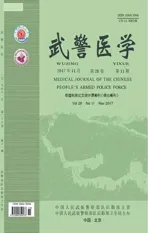地塞米松对小鼠体成分的影响
2017-12-20王月兵刘庆春鲁飞翔
王月兵,刘庆春,鲁飞翔,李 军,王 英
地塞米松对小鼠体成分的影响
王月兵1,刘庆春2,鲁飞翔2,李 军3,王 英1
目的探讨地塞米松对两种不同年龄小鼠体成分的影响,筛选出较为理想的肌肉衰减综合征模型。方法C57BL/6雄性小鼠,8~10周龄随机分为2组,对照组(NA)和实验组(DA),6~7月龄随机分为2组,对照组(NM)和实验组(DM)。每组8只,对照组注射生理盐水,实验组注射5 mg/kg 地塞米松,皮下注射19 d。每3 d测量小鼠体成分,最后一次给药24 h后,利用Echo MRITM检测小鼠体成分。结果干预后,DA组与NA组相比,体重降低5.97%(P<0.05),肌肉量降低14.33%(P<0.01),脂肪量增加32.94%(P<0.05)。DM组和NM组相比,体重增加13.67%(P<0.05),肌肉量降低6.06%(P<0.05),脂肪量增加43.77%(P<0.01)。6~7月龄和8~10周龄小鼠相比,地塞米松对肌肉的干预效果无统计学差异(P=0.148),地塞米松对脂肪的干预效果具有统计学差异(P<0.05),6~7月龄小鼠脂肪的增加高于8~10周龄小鼠。结论本实验的干预条件下,6~7月龄小鼠较8~10周龄小鼠更适于做长期研究的肌肉衰减综合征模型。
地塞米松;肌肉;脂肪;肌肉衰减综合征
地塞米松常用于抗炎和抗过敏,但高剂量或是长期使用会引起一些不良反应[1]。有研究显示,长期服用地塞米松可引起糖、脂和蛋白代谢的改变[2]。同时,地塞米松可导致体重降低,促进肌肉萎缩,使肌肉相关蛋白减少和损伤肌功能等[3,4]。肌肉衰减综合征是一种进行性全身广泛性的骨骼肌纤维体积、数量和质量减少,骨骼肌力量下降和功能减退的综合征;主要临床表现为肌力衰退、肌肉松弛、活动力下降、体质量及去脂体质量降低,甚至导致平衡障碍、下床困难、频繁跌倒、骨质疏松等[5]。因此,有研究利用地塞米松来建立肌肉衰减综合征动物模型。但目前尚无地塞米松建模的相应的标准,此外针对地塞米松对小鼠体成分影响的具体研究尚未见报道。本研究旨在通过探讨地塞米松对两种不同年龄小鼠体成分的影响,为肌肉衰减综合征的相关研究提供基础实验依据。
1 材料与方法
1.1 实验动物及分组 8~10周龄和6~7月龄清洁级雄性C57BL/6小鼠,体重分别为20~25 g和30~35 g,购自北京维通利华提供实验动物技术有限公司,许可证编[SCXK(京)2012-0001],饲养于北京大学实验动物中心,许可证编号(SYXK(京)2011-0003)。按照国家标准啮齿类动物饲料喂养,动物自由摄食、饮水,光照为明暗12/12 h交替。动物实验经过动物福利委员会审批。8~10周龄随机分为实验组(DA)和对照组(NA),同样,6~7月龄小鼠随机分为实验组(DM)和对照组(NM)。每组8只,每只小鼠分笼饲养。
1.2 地塞米松干预 适应性饲养1周后,随机分组。称重和检测体成分。检测24 h后,每天对实验组和对照组小鼠进行皮下注射5 mg/kg地塞米松和生理盐水,剂量为0.1 ml/10 g,连续19 d。
1.3 体成分检测 称重后,将小鼠放置在相应型号的透明塑料动物舱内,动物舱插入Echo MRITM内,扫描得到小鼠的肌肉和脂肪含量。注射地塞米松前检测1次,注射后每3 d检测1次。

2 结 果
2.1 对体重的影响 干预19 d后,8~10周龄小鼠实验组(DA)与对照组(NA)相比,体重降低5.97%(P<0.05),6~7月龄小鼠实验组(DM)与对照组(NM)相比,体重增加13.67%(P<0.05,表1)。

表1 两组8~10周龄及6~7月龄小鼠干预前后体重的比较 (n=8;;g)
注:与干预前比较,①P<0.05
2.2 小鼠肌肉量变化 由表2可以看出,干预前,8~10周龄和6~7月龄实验组小鼠的肌肉量与各自对照组相比,差异均无统计学意义。干预后,8~10周龄实验组小鼠与对照组相比,肌肉量降低了14.33%(P<0.01)。6~7月龄实验组小鼠与对照组相比,肌肉量降低了6.06%(P<0.05)。
2.3 小鼠脂肪变化 干预前,8~10周龄和6~7月龄实验组小鼠的脂肪量与各自对照组相比,差异均无统计学意义。干预后,8~10周龄实验组小鼠与对照组相比,脂肪量增加了32.94%(P<0.05)。6~7月龄实验组小鼠与对照组相比,脂肪量增加了43.77%(P<0.01,表3)。

表2 两组8~10周龄及6~7月龄小鼠干预前后肌肉量的比较 (n=8;;g)

表3 两组8~10周龄及6~7月龄小鼠干预前后脂肪量的比较 (n=8;;g)
注:与干预前比较,①P<0.05
2.4 地塞米松干预前后8~10周龄和6~7月龄小鼠体成分比较 8~10周龄和6~7月龄小鼠相比,地塞米松对肌肉的干预效果无统计学差异(P=0.148);地塞米松对脂肪的干预效果具有统计学差异(P=0.026),6~7月龄小鼠脂肪的增加高于8~10周龄小鼠(P<0.05,表4)。

表4 地塞米松干预前后8~10周龄和6~7月龄小鼠体成分与体重的比值 (n=8;
注:与8~10周龄比较,①P<0.05
3 讨 论
本研究利用Echo MRITM检测8~10周龄和6~7月龄小鼠体成分。地塞米松干预19 d后,8~10周龄小鼠实验组与对照组相比,体重降低,这与Nicastro等[6]研究中地塞米松干预后大鼠体重降低的结果是一致的。6~7月龄小鼠实验组与对照组相比,体重增加,由本研究的结果可看出体重增加的主要影响因素是脂肪的增加。这可能是因为6~7月龄小鼠与8~10周龄小鼠相比,基础代谢下降,活动量减少,若和8~10周龄小鼠摄取同等的热量,会因热量无法消耗而在体内堆积。同时皮质激素会刺激食欲,抑制饱腹感,在自由摄食的情况下,小鼠可能会摄入过量,导致脂肪的增加。
本研究中,地塞米松干预后,8~10周龄和6~7月龄小鼠实验组与各自的对照组相比,肌肉量均降低,脂肪量均增加,且均具有统计学差异。这说明本研究的干预条件对两种不同年龄小鼠均可诱导为肌肉衰减综合征模型动物。从本研究地塞米松小鼠肌肉和脂肪的干预效果来看,6~7月龄和8~10周龄小鼠相比,地塞米松对肌肉的干预效果无统计学差异,而对脂肪的干预效果具有统计学差异,6~7月龄小鼠脂肪的增加高于8~10周龄小鼠。这表明当研究肌肉类疾病,即主要研究肌肉的变化时,8~10周龄和6~7月龄小鼠地塞米松建模的效果基本相同。但当涉及到有脂肪明显增加或是肥胖时,6~7月龄小鼠地塞米松建模的效果可能比8~10周龄效果好。当涉及到肌肉减少后,运动干预时,6~7月龄小鼠可能比8~10周龄好。8~10周龄地塞米松干预后,出现肌肉减少的同时,体重降低,运动干预可能会导致过耗。6~7月龄小鼠地塞米松干预后,出现肌肉减少的同时,体重增加,运动干预可能会使其脂肪降低,调节机体糖脂代谢,可能效果较8~10周龄理想[7-10]。从长期研究和应用的角度考虑,6~7月龄小鼠地塞米松建模可能较8~10周龄理想。
下一步我们将对摄食量进行控制,探究地塞米松干预后8~10周龄小鼠体重下降和6~7月龄小鼠体重增加的原因。目前有研究显示地塞米松注射5-6天可以影响下肢肌肉蛋白的合成[11],地塞米松干预10天可导致骨骼肌糖原贮存减少[2]。但地塞米松干预10~15 d的相关数据少见报道,仍需进一步研究证实。
[1] Dionísio T J, Louzada J C, Viscelli B A,etal.Aerobic trainingprevents dexamethasone-induced peripheral insulin resistance[J]. Horm Metab Res, 2014, 46(7): 484-489.
[2] Barel M, Perez O A, Giozzet V A,etal. Exercisetraining prevents hyperinsulinemia, muscular glycogen loss and muscle atrophyinduced by dexamethasone treatment[J]. Eur J Appl Physiol, 2010, 108(5): 999-1007.
[3] Kaasik P, Umnova M, Pehme A,etal.Ageing anddexamethasone associated sarcopenia: peculiarities of regeneration[J]. J Steroid Biochem Mol Biol,2007,105(1-5):85-90.
[4] Macedo A G, Krug A L, Herrera N A,etal. Low-intensityresistance training attenuates dexamethasone-induced atrophy in the flexorhallucis longus muscle[J]. J Steroid Biochem Mol Biol, 2014,143(5): 357-364.
[5] 周仙杰,李 军,鲁飞翔,等. 肌肉衰减综合征诊断标准及诊断指标测量方法研究进展[J].山东医药, 2016, 56(5): 107-109.
[6] Nicastro H, Gualano B, de Moraes W M,etal. Effects of creatine supplementation on muscle wasting and glucose homeostasis in ratstreated with dexamethasone [J].Amino Acids,2012, 42(5): 1695-1701.
[7] Rafacho A, Giozzet V A, Boschero A C,etal. Functional alterations inendocrine pancreas of rats with different degrees of dexamethasone-inducedinsulin resistance[J]. Pancreas, 2008, 36(3): 284-293.
[8] Qi D, Pulinilkunnil T, An D,etal. Single-dose dexamethasone induces whole-bodyinsulin resistance and alters both cardiac fatty acid and carbohydrate metabolism [J]. Diabetes, 2004, 53(7):1790-1797.
[9] Liu J, Peng Y, Wang X,etal. Mitochondrial dysfunction launches dexamethasone-induced skeletal muscle atrophy via AMPK/FOXO3 signaling [J]. Mol Pharm, 2016, 3(1): 73-84.
[10] Krug A L, Macedo A G, Zago A S,etal. High-intensityresistance training attenuates dexamethasone-induced muscle atrophy[J].Muscle Nerve, 2016, 53(5): 779-788.
[11] Savary I, Debras E, Dardevet D,etal. Effect of glucocorticoid excess on skeletal muscle and heart protein synthesis in adult and old rats [J]. Br J Nutr, 1998, 79(3): 297-304.
Effectofdexamethasoneonbodycompositioninmice
WANG Yuebing1, LIU Qingchun1, LU Feixiang1, LI Jun2, and WANG Ying1.
1.Department of Nutrition,2.Snpply Center,General Hospital of Chinese People’s Armed Police Force,Beijing 100039,China;3.Laboratory Animal Center, Peking University, Beijing 100871, China
ObjectiveTo explore the effect of dexamethasone on body composition of mice of two different ages in order to select an ideal sarcopenia model.MethodsC57BL/6 mice aged 8-10 weeks were randomly divided into the experimental group(DA) and control (NA),while another sixteen C57BL/6 mice aged 6-7 months were randomly assgined to the experimental group(DM) and control (NM). There were eight mice in each group.The control group
0.9% saline injection, while the experimental group was subcutaneously injected with 5 mg/kg dexamethasone for 19 days. The body composition of all the mice was measured every three days. 24h after the final administration,the body composition was measured with EchoMRITM.ResultsAfter dexamethasone intervention, compared with NA group, weight in DA group was reduced by 5.97% (P<0.05), muscle mass by 14.33%(P<0.01)but fat mass increased by 32.94%(P<0.05).Compared with NM group, weight in DM group increased by 13.67% (P<0.05), muscle mass reduced by6.06%(P<0.05)and fat mass increasedby 43.77%(P<0.01). There was no significant difference in the intervention effect of dexamethasone on muscle between mice of 6-7 months old and those of 8-10 weeks old(P>0.05), but the intervention effect of dexamethasone on fat was significantly different (P< 0.05).Fat of mice of 6-7 months old was increased more significantly than that of 8-10-week-old mice.ConclusionsUnder the conditions of this experiment,mice of 6-7 months old are more suitable for a long-term study of a sarcopenia model than mice of 8-10 weeks old.
dexamethasone; muscle; fat;sarcopenia
R685;R153.3
武警总医院院级课题(WZ2016019)
王月兵,硕士研究生,护师。
1.100039 北京,武警总医院:1.护理部,2.采购中心;3.100871,北京大学实验动物中心
王 英, E-mail: wangying3976@sina.com
(2017-05-10收稿 2017-08-05修回)
(责任编辑 武建虎)
